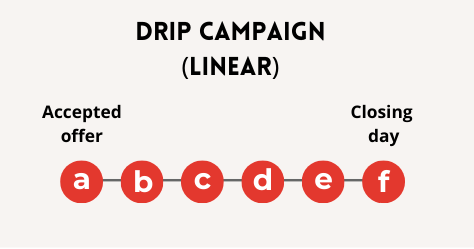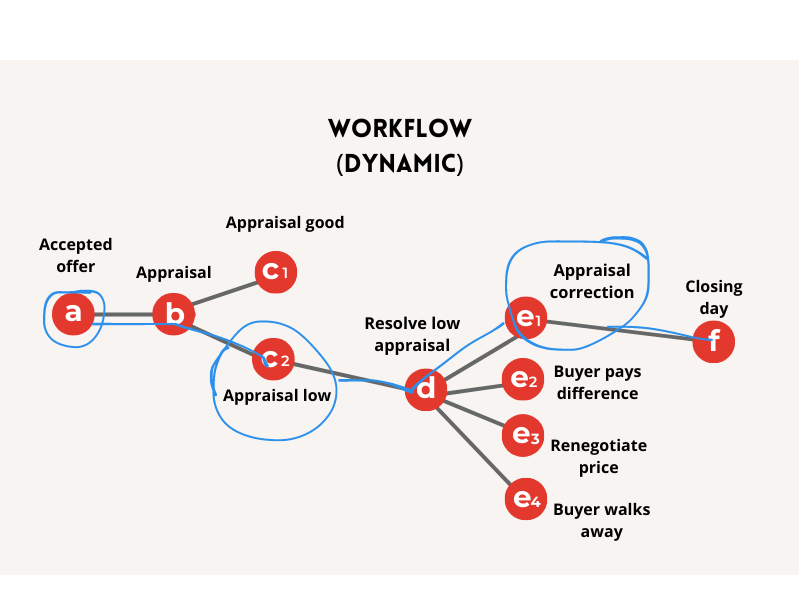If you’re a real estate agent in the modern age, you probably use an email service like MailChimp—or the email tool within your CRM—to send drip email campaigns to your contact list.
What is a drip email campaign?
A drip email campaign is a series of emails scheduled ahead of time to send on a consistent schedule—once a month, for example—with the goal of progressing people through your real estate sales funnel. It’s a way of nurturing your relationships with the people in your database, staying top-of-mind, demonstrating your value and expertise, and eventually earning their business.
But if not handled properly, drip email campaigns can actually hurt your relationships with your real estate clients and leads.
The Problem With Drip Campaigns
Far too many real estate agents mishandle their drip email campaigns. “People have a tendency to overestimate the value of drip email campaigns or overestimate their own abilities to extract value from those campaigns,” says SEO.co CRO Timothy Carter in an article for Entrepreneur. “Just because it’s easy to get started with something doesn’t mean it’s easy to capitalize on its full value.”
And when you don’t get your drip campaigns right, you can actually harm the client relationships you’ve worked so hard to build.
3 Common Drip Campaign Mistakes That Can Harm Your Relationships:
1) Failing to craft useful, valuable, relevant content.
A drip campaign is not the place to tout your achievements or advertise your real estate business. Instead, these emails should be providing your contacts with valuable, useful information that helps them in some way. Otherwise, you’re just one more annoying brand sending them junk mail.
2) Sending the same generic content to one giant list.
If you don’t segment your database into different email lists (buyers, past clients, dog owners, Millennials, etc.), it’s going to be impossible to provide truly valuable, relevant content. Everyone in your database is so different, with unique circumstances, lifestyles, interests, perspectives, budgets, and timelines. If you try to appeal to everyone, you’ll appeal to no one.
3) Limiting yourself to a linear campaign.
This can be a difficult mistake to avoid because, unfortunately, many CRMs and email marketing services have limited capabilities. They only allow for simple, linear drip campaigns. And real estate transactions aren’t simple or linear; they’re messy and complicated, and sometimes you jump ahead two steps, and sometimes you have to circle back seven steps.
Consider this linear drip email campaign:
- Week 1: “How To Stage Your Home For Listing Photos”
- Week 2: “Tips for Preparing Your Home for an Open House”
- Week 3: “What To Do With Your Pet During A Showing”
It’s a nice, tidy, 1-2-3 sequence of events. But is that how the listing is actually going to go? Nope.
In a transaction, there are too many what ifs, for better or for worse:
- What if the client doesn’t want an open house? That Week 2 email is irrelevant.
- What is their home goes under contract in just 3 days? The Week 3 email is too late.
- What if their dog just died? The Week 3 email is insensitive and oblivious.
You can see how a linear drip campaign can create tension in your relationships with your clients. The automation—while so convenient and time-effective for you—lacks the human element needed to effectively and authentically nurture your relationships.
Fortunately, there’s a solution: workflows.
Workflows: The better way to automate your communications!
What’s a workflow, you ask? Think of it like a drip campaign that was bitten by a radioactive spider and generated all sorts of incredible superpowers. Like, instead of walking in a straight line down the street, it can scale walls and leap across rooftops and do mid-air somersaults.
Or, maybe think about it this way: With a workflow, you are still automating your emails, but you’re doing it in an incredibly relevant and timely manner. (And it’s not just emails—also phone calls, texts, in-person visits, and more!)
Workflows are based on an “if this, then that” mentality. Such as, “if the appraisal comes back low, we need to pause everything until that’s resolved.” This is where workflows really differ from drip campaigns. Workflows are dynamic and capable of branching off in different directions; drip campaigns are linear. (In the appraisal example above, if it were a drip campaign, the next email would send as originally scheduled, not taking into account the change of plans.)
The images below illustrate the difference between a linear drip campaign and a dynamic workflow.


With workflows, communications are sent at the perfect time, whether it’s on an exact date (such as a client’s birthday), based on a milestone date (1 day after listing on MLS), or after a delay (send after paperwork is signed).
Workflows recognize that some situations require a quick manual action. When using workflows, you might suddenly get a notification prompting you to decide whether Mary Smith should receive Email A or Email B. It’s the little personalized details like this that make your communications feel more authentic and human.
You can easily move contacts from one workflow to another as the relationship evolves. Once your buyer closes on their home, for example, you can move them into a “past client nurture” workflow that will begin them on a new phase of the nurturing journey.
It’s Time To Ditch The Drip Campaigns
Drip email campaigns are so 2010. Today, the savviest of real estate agents are using workflows to automate long-term communications with leads and clients. For more control and flexibility when it comes to your email marketing, say goodbye to drip campaigns—and hello to workflows.
Learn how you can use Realvolve workflows to automate email campaigns, real estate transactions, and more!





